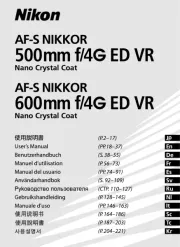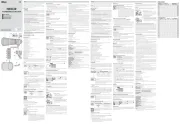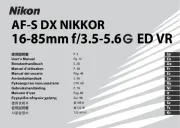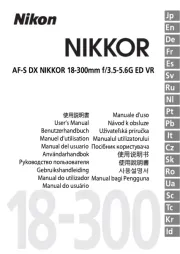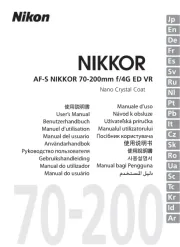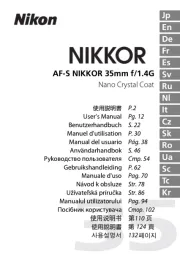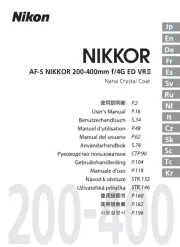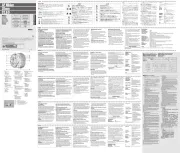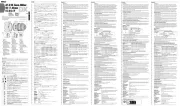
Printed in China TT2I13 (80) 7MAA0580-13 r
使用説明書の内容が破損などに て判読できよっ なくなったときは、ニコンサービス機関にて新しい使用説明書をお求めください(有料)。
No reproduction in any form of this manual, in whole or in part (except for brief
quotation in critical articles or reviews), may be made without written authorization
You are now the proud owner of the AF Nikkor 50mm f/1.8D, a lens that will provide you with years
of exciting picture-taking opportunities. Before using this lens, please read these instructions and
the notes on safety operations in your camera’s user’s manual. Also, keep this manual handy for
• Autofocus operation is possible with Nikon autofocus cameras (except the F3AF and cameras with lens mounts that do
not have AF coupling); manual focus possible with all Nikon SLRs.
• Compact and lightweight. Ideal for a high-speed normal lens with a maximum aperture of f/1.8.
• For more accurate exposure control, subject distance information is transmitted from the lens to the camera body,
providing 3D Matrix Metering and 3D Multi-Sensor Balanced Fill-Flash with appropriate Nikon cameras and
• Be careful not to soil or damage the CPU contacts.
• Do not attach the following accessories to the lens, as they might damage the lens CPU contacts:
Auto Extension Ring PK-1, PK-11 (use PK-11A), Auto Ring BR-4 (use BR-6 with BR-2A), and K1 Ring.
Other accessories may not be suitable when this lens is used with certain camera bodies. For details, refer to user’s
• This lens is not compatible when used with a Nikon F3AF camera with the AF Finder DX-1 attached.
If your camera has a depth of field preview (stop-down) function, depth of field can be observed while looking through the
Recommended focusing screens
Various interchangeable focusing screens are available for certain Nikon SLR cameras to suit any type of lens or picture-
taking situation. Those recommended for use with this lens are listed in the table.
Slight vignetting or moiré patterns appear in the viewfinder, but not on the film.
The in-focus image in the central spot may prove to be slightly out of focus on film. Focus on the surrounding matte
( ) : Indicates degree of exposure compensation needed (Center-Weighted metering only). For F6 cameras, compensate by
selecting “Other screen” in Custom Setting “b6: Screen comp.” and setting the EV level to -2.0 to +2.0 in 0.5 EV steps.
When using screens other than type B or E, “Other screen” must be selected even when the required compensation value
is “0” (no compensation required). For F5 cameras, compensate using Custom Setting #18 on the camera body. For
F4-Series cameras, compensate using the Exposure Compensation Dial for the focusing screen.
See user’s manual of the camera body for more details.
Blank box means not applicable. Since type M screen can be used for both macrophotography at a 1:1 magnification ratio
and for photomicrography, it has different applications than other screens.
• When using the B/B2/B3, E/E2/E3, and K/K2/K3 focusing screens in cameras other than those listed above, refer to the
columns on the F4 + DP-20’s B, E and K screens, respectively.
Minimum aperture lock (Fig. A)
For programmed auto or shutter-priority auto exposure shooting, use the minimum aperture lock lever to lock the lens
1 Set the lens to its minimum aperture (f/22) by aligning it with the aperture index.
2 Slide the lock lever toward the aperture ring, so the two orange dots are aligned.
To release the lock, slide the lever in the opposite direction.
Taking flash pictures with cameras with a built-in flash
All Nikon cameras with a built-in flash are usable and no vignetting occurs.
• To remove dirt and smudges, use a soft, clean cotton cloth or lens tissue moistened with lens cleaner. Wipe in a circular
motion from the center outward. • Never use thinner or benzene to clean the lens as this might damage the lens, result in
a fire, or cause health problems. • To protect the front lens element, an NC filter is recommended at all times. A lens
hood also helps protect the front of the lens. • When storing the lens in the lens case, attach both front and rear caps.
• When the lens will not be used for a long time, store it in a cool, dry place to prevent mold. Also store the lens away
from direct sunlight or chemicals such as camphor or naphthalene. • Do not get water on the lens or drop it in water as
this will cause it to rust and malfunction. • Reinforced plastic is used for some parts of the lens. To avoid damage, never
leave the lens in an excessively hot place.
Standard accessories •52mm snap-on front lens cap
Optional accessories •52mm screw-in filters •Flexible lens pouch CL-0715 •Rubber lens hood HR-2 •Rear
Type of lens: D-type AF Nikkor lens having built-in CPU and Nikon bayonet mount
Lens construction: 6 elements in 5 groups
Picture angle: 46° [31°30’ with Nikon digital cameras (Nikon DX format); 38° with IX240 system cameras]
Distance information: Output to camera body
Focusing: Autofocus; manually via separate focus ring
: Graduated in meters and feet from 0.45m (1.75 ft) to infinity ( ) ∞
Closest focus distance: 0.45 m (1.5 ft) from focal plane
Aperture scale: f/1.8 to f/22 on both standard and aperture-direct-readout scales
Diaphragm: Fully automatic
: Via full-aperture method with AI cameras or cameras with CPU interface system; via stop-
down method for other cameras
Attachment size: 52mm (P = 0.75mm)
Dimensions: Approx. 63.5mm dia. x 39mm (extension from the camera’s lens mounting flange)
Weight: Approx. 155g (5.5 oz)
Specifications and designs are subject to change without any notice or obligation on the part of the manufacturer.
Notices for Customers in Europe
This symbol indicates that electrical and electronic equipment is to be collected separately.
The following apply only to users in European countries:
• This product is designated for separate collection at an appropriate collection point. Do not
dispose of as household waste.
• Separate collection and recycling helps conserve natural resources and prevent negative
consequences for human health and the environment that might result from incorrect disposal.
• For more information, contact the retailer or the local authorities in charge of waste management.
Wir danken Ihnen für das Vertrauen, das Sie Nikon mit dem Kauf des AF Nikkor 50 mm f/1.8D
bewiesen haben, und wir hoffen, daß Sie viele Jahre ungetrübte Freude an Ihrem neuen Objektiv
haben werden. Bitte lesen Sie diese Gebrauchsanweisung sorgfältig durch sowie die
entsprechenden Abschnitte im Benutzerhandbuch Ihrer Kamera. Bewahren Sie diese Anleitung für
späteres Nachschlagen griffbereit auf.
• Autofokusbetrieb mit entsprechend ausgerüsteten Nikon-Autofokuskameras (außer F3AF und Kameras, die kein Bajonett
mit AF-Anschlussstück haben); manuelle Schärfeneinstellung bei allen Nikon-Spiegelreflexkameras.
• Kompakt und leicht im Gewicht. Ideal für ein lichtstarkes Normalobjektiv mit einer größten Blendendöffnung von 1:1,8.
• Für noch genauere Belichtungsregelung wird die Distanz zum Aufnahmeobjekt vom Objektiv an die Kamera übermittelt,
so daß 3D-Matrix-Messung sowie 3D-Multi-Sensor-Aufhellblitzen mit entsprechend geeigneten Nikon-Kameras und
Nikon-Blitzgeräts möglich ist.
• Halten Sie die CPU-Kontakte peinlich sauber, und schützen Sie sie vor Beschädigung!
• Folgendes Zubehör darf nicht an das Objektiv angesetzt werden, da es die CPU-Kontakte beschädigen könnte:
Automatik-Zwischenring PK-1, PK-11 (stattdessen PK-11A verwenden), Automatikring BR-4 (stattdessen BR-6 mit
BR-2A verwenden) und Zwischenring K1. Anderes Zubehör kann bei Verwendung des Objektivs mit gewissen
Kameramodellen ungeeignet sein. Einzelheiten entnehmen Sie bitte dem jeweiligen Benutzerhandbuch.
• Das Objektiv ist nicht zur Verwendung mit der Nikon F3AF mit angesetztem AF-Sucher DX-1 geeignet.
Verfügt die Kamera über eine Taste oder einen Hebel zur Schärfentiefe-Vorschau (Abblendung), so läßt sich die
Schärfentiefe im Kamerasucher verfolgen.
Empfohlene Einstellscheiben
Für bestimmte Nikon-Kameras stehen verschiedene auswechselbare Einstellscheiben zur Verfügung, um jeder
Aufnahmesituation gerecht zu werden. Die zur Verwendung mit diesem Objektiv empfohlenen sind nachstehend
◎ : Hervorragende Scharfeinstellung
○ : Akzeptable Scharfeinstellung
Das Sucherbild vignettiert leicht. Die Aufnahme selbst bleibt hiervon unberührt.
△ : Brauchbare Scharfeinstellung
Das im mittleren Kreis scharf eingestellte Bild könnte auf dem Film leicht unscharf abgebildet werden. Stellen Sie auf dem
umliegenden Mattfeld scharf.
( ) : Zeigt den Betrag zusätzlich erforderlicher Belichtungskorrektur (Nur mittenbetonte Belichtungsmessung). Bei F6-Kameras
korrigieren Sie durch Wahl von “Andere” in der Individualfunktion “b6: Einstellscheibe” und Einstellen des LW-Werts im Bereich
zwischen –2,0 und +2,0 in 0,5-LW-Schritten. Bei Gebrauch von anderen Scheiben als B oder E, ist “Andere” auch dann zu wählen,
wenn der erforderliche Korrekturwert “0” beträgt (keine Korrektur nötig). Zur Einstellung des Korrekturwerts am F5 Kameragehäuse
dient die Individualfunktion Nr. 18. Mit den F4-Serien-Geräten durch den Belichtung-Kompensationsanzeiger für
Visiermattscheiben kompensieren.
Näheres hierzu finden Sie im Benutzerhandbuch des Kameragehäuses.
Ein Leerfeld bedeutert: unbrauchbar. Da die Einstellscheibe M sowohl für Maktrofotografie bis zum Abbildungsmaßstab 1:1 als auch
Mikrofotografie eingesetzt werden kann, unterscheidet sich ihr Anwendungsbereich von dem anderer Einstellscheiben.
• Bei Verwendung der Scheiben B/B2/B3, E/E2/E3 bzw. K/K2/K3 in anderen als den obengenannten Kameras gelten die Spalten für die
Scheiben B, E bzw. K auf F4 + DP-20.
Verriegelung auf kleinster Blende (Abb. A)
Für Programm- und Blendenautomatik muß der Blendenring auf kleinster Öffnung (22) verriegelt werden.
1 Drehen Sie den Blendenring, bis die Blendenzahl 22 dem Blendenindex gegenübersteht.
2 Schieben Sie den Riegel in Richtung auf den Blendenring, so daß die beiden orangefarbenen Punkte aufeinander
Zur Entriegelung schieben Sie den Riegel in die entgegengesetzte Richtung.
Blitzaufnahmen mit Kameras mit eingebautem Blitz
Dieses Objektiv ist ohne jegliche Vignettierungen für Blitzaufnahmen mit allen Nikon-Kameras mit eingebautem Blitz
• Reinigen Sie die Linsenoberfläche mit einem leicht mit Linsenreiniger angefeuchteten weichen, sauberen Baumwolltuch
oder Linsenreinigungspapier. Wischen Sie dabei in einer größer werdenden Kreisbewegung von innen nach außen.
• Verwenden Sie keinesfalls Verdünnung oder Benzin zur Reinigung, da dieses zu Beschädigungen führen,
Gesundheitsschäden verursachen oder ein Feuer auslösen könnte. • Zum Schutz der Frontlinse empfiehlt es sich, stets
ein NC-Filter aufgesetzt zu lassen. Die Gegenlichtblende wirkt als zusätzlicher Frontlinsenschutz. • Bei Aufbewahrung
des Objektivs in seinem Köcher sollten beide Objektivdeckel aufgesetzt sein. • Bei längerer Nichtbenutzung sollte das
Objektiv an einem kühlen, trockenen Ort aufbewahrt werden. Halten Sie das Objektiv von direkter Sonneneinstrahlung oder
Chemikalien wie Kampfer oder Naphthalin fern. • Halten Sie das Objektiv von Wasser fern, das zur Korrosion und zu
Betriebsstörungen führen kann. • Einige Teile des Objektivs bestehen aus verstärktem Kunststoff. Lassen Sie das Objektiv
deshalb nie an übermäßig heißen Orten zurück!
Serienmäßiges Zubehör •Aufsteckbarer Frontdeckel 52mmφ
Sonderzubehör •Einschraubfilter 52 mm •Objektivbeutel CL-0715 •Gummi-Gegenlichtblende HR-2 φ
Objektivtyp: AF Nikkor mit D-Charakteristik, eingebauter CPU und Nikon-Bajonett
Maximale Blendenöffnung: f/1,8
Optischer Aufbau: 6 Linsen in 5 Gruppen
Bildwinkel: 46° [31°30’ bei Nikon-Digitalkameras (Nikon DX-Format); 38° bei IX240-Kameras]
Entfernungsdaten: Werden an Kameras übertragen
Schärfeneinstellung: Autofokus; manuell über separaten Fokussierring
Entfernungsskala: Unterteilt in Meter und Fuß und zwar von 0,45m bis Unendlich ( )∞
Kürzeste Aufnahmedistanz: 0,45 m von der Sensorebene gemessen
Blendenskala: f/1.8 — f/22, sowohl auf der Standardskala als auch der Skala für Blendendirekteinspiegelung
Blendenart: Vollautomatisch
Belichtungsmessung: Offenblendenmessung bei Kameras mit AI-Blendenkupplung oder CPU-Interface-System;
Arbeitsblendenmessung bei allen anderen Kameras
Befestigungsgröße: 52 mm (P = 0,75mm)
Abmessungen: ca. 63,5 mm Durchm. x 39 mm (Länge bis Flansch)
Änderungen von technischen Daten und Design durch den Hersteller vorbehalten.
Hinweise für Kunden in Europa
Durch dieses Symbol wird angezeigt, dass elektrische bzw. elektronische Geräte getrennt entsorgt
Folgendes gilt für Verbraucher in europäischen Ländern:
• Dieses Produkt muss an einer geeigneten Sammelstelle separat entsorgt werden. Eine Entsorgung
über den Hausmüll ist unzulässig.
• Durch getrennte Entsorgung und Recycling können natürliche Rohstoffe bewahrt und die durch
falsche Entsorgung verursachten, schädlichen Folgen für die menschliche Gesundheit und Umwelt
• Weitere Informationen erhalten Sie bei Ihrem Fachhändler oder bei den für die Abfallentsorgung
zuständigen Behörden bzw. Unternehmen.
このたびは、ニッコールレンズをお買い上げいただきありがとうございます。
ご使用の前にこの「使用説明書」をよくお読みのうえ、十分に理解してから正し
くお使いください。お読みになった後は、お使いになる方がいつでも見られる所
ニコンの AF[オートフォーカス(レンズマウントに AF カップリングがないカメラ、F3AF
を除く)]カメラとの組み合わせでオートフォーカス撮影ができます。また、マニュアル(手
軽量・コンパクトで、また開放 F 値が F1.8 と非常に明るく、標準レンズとして最適です。
被写体までの距離情報をカメラボディーに伝達する機能を備えていますので、距離情報に対
応したニコンカメラやフラッシュ使用時、より的確な露出制御を実現する3D-マルチパターン
レンズの CPU 信号接点は汚さないようにご注意ください。
CPU 信号接点を破損しますので、オート接写リング PK-1、PK-11、オートリングBR-4 ま
たは K1 リングはご使用になれません(PK-11 の代わりには PK-11A リングを、またオート
リング BR-4 の代わりには BR-6 と BR-2A を組み合わせてご使用ください)。その他のアク
セサリーとカメラボディーとの組み合わせ使用に際しては、必ず各製品の使用説明書も併せて
ニコン F3AF 用DX-1 ファインダーと組み合わせての使用はできません。
プレビュー(絞り込み)機構を持つカメラでは、撮影前に被写界深度を確認することができ
ニコン F6、F5、F4 シリーズカメラボディーには、多種類のファインダースクリーンがあり、
レンズのタイプや撮影条件に合わせて最適なものを選べます。このレンズに適したファイン
ダースクリーンは、下表のとおりです。(なお、ご使用に際しては、必ず、各カメラボディー
○ :視野の一部が多少見にくくなりますが、撮影結果に全く影響がありません。
△ :スプリットの合致像は見えますが、ピント合わせは精度上適しません。
() :中央部重点測光時の補正値です。F6 カメラの場合、測光値の補正は、カメラのカスタム
メニュー「b6:スクリーン補正」を「BorE 以外」にセットして行います。B 型および
E 型以外を使用する場合は、補正量が 0 でも、「BorE 以外」にセットしてください。
F5 カメラの場合は、カスタムセッティング No.18 の設定で測光値の補正を行います。
F4 シリーズカメラの場合は、ファインダースクリーン露出補正ダイヤルを回して補正を
行います。詳しくはカメラの使用説明書をご覧ください。
空欄:使用不適当です。ただし、M スクリーンの場合、撮影倍率1/1 倍以上の近接撮影に
*上記以外のカメラで B /B2 /B3、E /E2 /E3、K /K2 /K3 スクリーンの見え方は、
それぞれ F4 +DP-20 の B、E、K スクリーンの欄を参考にしてください。
プログラムオートやシャッター優先オートによる撮影時は、絞りリングを最小絞りに固定して
おくことができます。まずレンズの絞りリングを回し、最小絞り(最も大きい数値)を絞り指
標に合わせます。次に、最小絞りロックレバーを絞りリングの方向にスライドし 2 つのオレン
ジ指標を合わせます。これで絞りリングは最小絞りでロックされます。ロックレバーを反対方
ニコンの全てのフラッシュ内蔵カメラは、画面のケラレなくお使いいただけます。
レンズ表面のホコリや汚れは、市販のレンズクリーナーを湿らせた柔らかい木綿の布で、中
シンナーやベンジンなどの有機溶剤は絶対に使用しないでください。
レンズ表面の汚れや傷を防ぐために、NC フィルターを常用することをおすすめします。また、
レンズをケースに入れるときは、必ず、レンズキャップを前後に取り付けてください。
レンズを長期間使用しないときは、カビやサビを防ぐために、高温多湿のところを避けて風
通しのよい場所に保管してください。また、直射日光のあたるところ、ナフタリンや樟脳の
レンズを水に濡らすと、部品がサビつくなどして故障の原因となりますのでご注意ください。
ストーブの前など、高温になるところに置かないでください。極端に温度が高くなると、外
観の一部に使用している強化プラスチックが変形することがあります。
型式: ニコン F マウント CPU 内蔵D タイプ、AF レンズ
画角: 46°(ニコンデジタル一眼レフカメラ[ニコン DX フォーマット]
装着時 31°30′、IX240 カメラ装着時 38°)
撮影距離情報: カメラボディーへの撮影距離情報出力可能
ピント合わせ: オートフォーカス(フォーカスリング回転によりマニュアルフォーカス
撮影距離目盛: ∞〜 0.45m、1.75ft(併記)
絞り目盛: 1.8、2.8、4、5.6、8、11、16、22
最小絞りロック可能(ファインダー内直読み用目盛併記)
測光方式: CPU・AI 方式のカメラボディーでは開放測光、従来方式のカメラボディー
大きさ: 約63.5mm(最大径)×約39mm(長さ:バヨネットマウント基準面
仕様、外観の一部を、改善のため予告なく変更することがあります。
Fig. A Levier de verrouillage d’ouverture
Fig. A Palanca de bloqueo de apertura
Fig. A Minimum aperture lock
Abb. A Verriegelung für kleinste Blende
Usted es ahora el nuevo propietario del AF Nikkor 50 mm f/1.8D, un objetivo para que pueda
disfrutar de muchos años de oportunidades para hacer fotografías excitantes. Antes de utilizar
este objetivo, lea estas instrucciones y las notas sobre un uso seguro en el manual del
usuario de su cámara. Guarde este manual en un lugar a mano para su referencia en el futuro.
• Es posible un funcionamiento con enfoque automático en las cámaras de enfoque automático de Nikon (excepto
F3AF y las cámaras con monturas del objetivo sin acoplamiento AF); aunque es posible el enfoque manual con
• Compacto y liviano. Ideal para un objetivo normal de alta velocidad con una apertura máxima
• Para un control de exposición más preciso, la información de distancia del objeto se transmite del objetivo a la
cámara, para una medición por matriz tridimensional y un flash de relleno balanceado con sensor múltiple
tridimensional, con las cámaras Nikon y Speedlights apropiados.
• Tener cuidado de no manchar o dañar los contactos de la CPU.
• No montar en el objetivo los siguientes accesorios, p1-ya que podrían dañar los contactos de la CPU: Anillo de
Autoextensión PK-1, PK-11 (utilice PK-11A), Anillo Auto BR-4 (utilice BR-6 con BR-2A) o Anillo K1.
Puede que otros accesorios no sean apropiados cuando se usa este objetivo con determinados cuerpos de
cámara. Para más detalles, ver el manual del usuario de cada producto.
• Este objetivo no se puede usar con una cámara Nikon F3AF que lleve montado el Visor AF DX-1.
Si su cámara tiene una función de previsualización de profundidad de campo (cierre de iris), puede observarse la
profundidad de campo mientras mira por el visor de la cámara.
Pantallas de enfoque recomendadas
Hay diferentes pantallas de enfoque intercambiables para algunas cámaras SLR de Nikon apropiados para
cualquier situación fotográfica. Las recomendadas para utilizar con este objetivo son las que aparecen en la lista a
Ligero viñeteo afecta la imagen de la pantalla, pero la imagen de la película no es afectada
La imagen enfocada en el circulo central puede resultar ligeramente desenfocada en la fotografía. Se aconseja enfocar
mediante el área mate circundante.
( ) : Indica la cantidad de compensación adicional necesaria (Solamente medición ponderada central). Para cámaras F6,
compense seleccionando “Otra pantalla” en el ajuste personal del usuario “b6: Compens pantalla” y ajustando el nivel EV a
-2,0 a +2,0 en pasos de 0,5 EV. Cuando se utilice una pantalla que no sea de tipo B o E, debe seleccionarse “Otra pantalla”
incluso cuando el valor de compensación requerido sea “0” (no se requiere compensación). Para la cámara F5 compense
usando el ajuste personal del usuario No. 18 en el cuerpo de la cámara. Para las cámaras de la serie F4, compense usando
el dial de compensación de exposición para las pantallas de enfoque.
Para más detalles, consulte el manual del usuario de la cámara.
Los blancos significan inaplicable. Como la pantalla de tipo M se usa para macrofotografía a una razón de aumento de 1:1 asi
como para microfotografía, su aplicación es distinta a la de las demás pantallas.
• Cuando se utilicen las pantallas de enfoque B/B2/B3, E/E2/E3 y K/K2/K3 en cámaras distintas de las relacionadas arriba, vea
las columnas de las pantallas B, E y K, de F4 + DP-20 respectivamente.
Bloqueo de la apertura mínima (Fig. A)
Para disparar con exposición automática programada o automática con prioridad al obturador, utilizar la palanca de
bloqueo de la apertura mínima para fijar la apertura del objetivo en f/22.
1 Ajustar el objetivo a su apertura mínima (f/22) alineándolo con el índice de apertura.
2 Deslice la palanca de fijación hacia el anillo de aperturas para que se alineen dos puntos naranjas.
Para desbloquearlo, deslizar la palanca en la dirección opuesta.
Cuando se hacen fotografías con flash en cámaras con flash incorporado
Todas las cámaras Nikon con flash incorporado pueden utilizarse sin que se produzca un viñetado.
Forma de cuidar el objetivo • Para eliminar la suciedad y las manchas, utilice un paño de algodón suave
y limpio o un papel para cristales empapado con limpiador de cristales. Limpie con un movimiento circular del
centro al borde exterior. • No usar en ningún caso disolvente o benceno para limpiar el objetivo p1-ya que podría
dañarlo, provocar un incendio o causar problemas sanitarios. • Se recomienda utilizar en todo momento un filtro
NC para proteger el elemento frontal del objetivo. También un parasol contribuirá a proteger la parte frontal del
objetivo. • Cuando se guarde el objetivo en su estuche, colocarle las dos tapas. • Cuando no se vaya a utilizar el
objetivo durante largo tiempo, guardarlo en un lugar fresco y seco para evitar la formación de moho. Guardar el
objetivo, además, lejos de la luz solar directa o de productos químicos tales como alcanfor o naftalina. • No
mojar el objetivo ni dejarlo caer al agua, p1-ya que se oxidaría y no funcionaría bien. • Algunas partes del objetivo
son de plástico reforzado. Para evitar daños, no dejarlo nunca en un lugar excesivamente caliente.
Accesorios estándar •Tapa frontal a presíon de 52mm
Accesorios opcionales •Filtros roscados de 52 mm •Bolsa de objetivo flexible CL-0715 •Parasol de
hule HR-2 •Tapa trasera del objetivo
Tipo de objetivo: AF Nikkor tipo D con CPU incorporada y montura de bayoneta Nikon
Estructura del objetivo: 6 lentes en 5 grupos
Angulo de imagen: 46° [31°30’ con cámaras digitales Nikon (Formato Nikon DX); 38° con cámaras de sistema
Información de distancia: Salida al cuerpo de la cámara
Enfoque: Enfoque automático; manual por anillo de enfoque independiente
Escala de distancias de las tomas:
Graduada en metros y en pies desde 0,45m hasta infinito ( )∞
Distancia de enfoque más cercana: 0,45 m a partir del plano focal
Escala de aberturas: f/1.8 — f/22 en escalas normales y de lectura directa de aberturas
Diafragma: Totalmente automático
Medición de la exposición: Método de abertura total con cámaras AI o cámaras con sistema de interfase CPU;
método de reducción de parada para otras cámara.
Tamaño de accesorios: 52 mm (P = 0,75mm)
Dimensiones: Aprox. 63,5 mm de diám. x 39 mm (desde la pestaña de montaje)
Las especificaciones y los diseños están sujetos a cambio sin previo aviso ni obligación por parte del fabricante.
Avisos para los clientes en Europa
Este símbolo indica que los equipos eléctricos y electrónicos deben ser desechados por
Las advertencias siguientes rigen únicamente para usuarios de países europeos:
• Este producto está diseñado para ser desechado por separado en un punto de recogida de
residuos adecuado. No lo tire con la basura doméstica.
• La recogida y el reciclaje por separado ayudan a conservar los recursos naturales y previenen
las consecuencias dañinas que una eliminación incorrecta podría ocasionar para la salud
humana y el medioambiente.
• Para obtener más información, puede ponerse en contacto con el vendedor o con las
autoridades locales encargadas de la gestión de residuos.
この表示を無視して、誤った取り扱いをすると、人が死亡または重傷を負う可能性が想定され
この表示を無視して、誤った取り扱いをすると、人が傷害を負う可能性が想定される内容およ
ご使用の前に「安全上のご注意」をよくお読みのうえ、正しくお使いください。この「安全上のご注意」は製品
を安全に正しく使用していただき、あなたや他の人々への危害や財産への損害を未然に防止するために、重要な
内容を記載しています。お読みになった後は、お使いになる方がいつでも見られる所に必ず保管してください。
△記号は、注意(警告を含む)を促す内容を告げるものです。図の中や近くに具体的な注意内容(左
記号は、禁止の行為(してはいけないこと)を告げるものです。図の中や近くに具体的な禁止内容
●記号は、行為を強制すること(必ずすること)を告げるものです。図の中や近くに具体的な強制内
容(左図の場合は電池を取り出す)が描かれています。
お守りいただく内容の種類を、次の絵表示で区分し、説明しています。
Echelle de lecture directe de
Escala de lectura directa de
Signalstift für kleinste Blende
Levier de signal d’ouverture
minimale (levier de servo
Borne de señal de abertura
Blenden-index/Objektivindex
Index d’ouverture/index de
Indice de aberturas/índice de
Ligne de repère des distance
Línea indicadora de distancias
Infrarot-Kompensationsindex
Repère de mise au point en
Echelle des profondeurs de
Verriegelung für kleinste
落下などによって破損し、内部が露出したときは、露出部に手を触れないこと
感電したり、破損部でケガをする原因となります。カメラの電池を抜いて、販売店または
熱くなる、煙が出る、こげ臭いなどの異常時は、速やかにカメラの電池を取り出すこと
そのまま使用すると火災、やけどの原因となります。電池を取り出す際、やけどに充分注意
してください。電池を抜いて、販売店またはニコンサービス機関に修理を依頼してください。
水につけたり、水をかけたり、雨にぬらしたりしないこと
プロパンガス・ガソリンなど引火性ガスや粉塵の発生する場所で使用すると、爆発や火災
太陽光がカメラ内部で焦点を結び、火災の原因になることがあります。画角から太陽を
使用しないときは、レンズにキャップをつけるか太陽光のあたらない所に保管すること
太陽光が焦点を結び、火災の原因になることがあります。
三脚にカメラやレンズを取り付けたまま移動しないこと
転倒したりぶつけたりしてケガの原因になることがあります。
窓を閉め切った自動車の中や直射日光が当たる場所など、異常に温度が高く
内部の部品に悪い影響を与え、火災の原因となることがあります。
Vous êtes maintenant l’heureux propriétaire d’un AF Nikkor 50mm f/1.8D, un objectif qui vous
permettra de prendre des photos remarquables pendant des années. Avant d’utiliser cet objectif,
veuillez lire ce mode d’emploi et les remarques sur la sécurité dans le manuel d’utilisation de votre
boîtier. Conservez ce manuel à portée de la main pour toute référence ultérieure.
Principales caractéristiques
• L’autofocus est possible avec un boîtier autofocus Nikon (sauf F3AF et les appareils photo à monture d'objectif sans
couplage AF), la mise au point manuelle avec tous les appareils reflex Nikon.
• Compact et léger. Idéal pour un objectif normal grande vitesse à ouverture maximale de f/1.8.
• Pour assurer un contrôle d’exposition plus précis, l’information de distance au sujet est transmise de l’objectif au boîtier,
ce qui permet la mesure matricielle 3D et le dosage auto flash/ambiance par multi-capteur 3D avec les boîtiers et flashes
• Veiller à ne pas salir ni endommager les contacts CPU.
• Ne pas essayer de monter les accessoires suivants, car ils risquent d’abimer les contacts: Bague d’auto-rallonge PK-1,
PK-11 (utilisez PK-11A), Bague auto BR-4 (utilisez la bague BR-6 avec BR-2A) et Bague K1.
D’autres accessoires peuvent ne pas convenir lorsque l’objectif est utilisé avec certains appareils. Se référer aux
• Cet objectif n’est pas compatible avec le boîtier F3AF équipé du viseur DX-1.
Si votre appareil est pourvu d’une fonction de prévisionnage de la mise au point (ouverture réelle), vous pouvez observer
la profondeur de champ en regardant dans le viseur.
Écrans de mise au point recommandés
Divers écrans de mise au point sont disponibles pour certains appareils Nikon SLR qui s’adaptent à toutes les conditions
de prise de vues. Les écrans recommandés avec cet objectif sont listés ci-dessons:
◎ : Mise au point excellente
○ : Mise au point passable
Un vignetage affecte l’image du verre. L’image sur la pellicule ne porte cependant aucune tracede ceci.
△ : Mise au point passable
L’image mise au point dans le cercle central pourrait s’avérer légèrement floue sur la pellicule. La mise au point doit donc être faite
sur la couronne dépolie entourant le cercle central du verre de visée.
( ) : Indique la compensation de l’exposition additionnelle requise (Mesure pondérée centrale uniquement). Pour les appareils F6, corrigez en
sélectionnant “Activ.: autre” dans le réglage personnalisé “b6: Plage visée” et en réglant le niveau IL de -2,0 à +2,0 par pas de 0,5 IL.
Lorsque vous utilisez des verres autres que ceux de type B ou E, il faut sélectionner “Activ.: autre” même lorsque la valeur de correction
est de “0” (pas de correction nécessaire). Pour les appareils F5, compenser en utilisant le réglage personnalisé n° 18 sur l’appareil. Pour
les appareils de la série F4, compenser en utilisant le cadran de compensation de l’exposition prévu pour les filtres de mise au point.
Voyez le manuel d’utilisation de l’appareil photo pour plus de détails.
Un blanc indique aucune application. Du fait que le verre M peut être utilisé pour la macrophotographie à un rapport d’agradissement 1:1 et
pour la photomicrographie, il a des applications diffèrentes de celles des autres verres.
• Lors de l’utilisation de verres B/B2/B3, E/E2/E3 ou K/K2/K3 dans des appareils autres que ceux indiqués ci-dessus, se reporter
respectivement aux colonnes des verres B, E, K de F4 + DP-20.
Blocage d’ouverture minimale (Fig. A)
En mode Programme ou Auto priorité vitesse, réglez puis verrouillez le diaphragme sur l’ouverture minimale (f/22).
1 Réglez le diaphragme sur l’ouverture mini (f/22) en alignant sur le repère d’ouverture.
2 Glissez le curseur de blocage vers la bague de diaphragme de sorte que les deux points orange soient alignés.
Pour débloquer, glissez le curseur dans l’autre direction.
Prise de vues au flash avec un appareil à flash intégré
Tous les appareils Nikon à flash intégré sont utilisables et il n’y a pas de vignettage.
Soin de l’objectif • Utilisez un chiffon en coton doux et propre ou du tissu de nettoyage pour objectif légèrement
humidifié de liquide de nettoyage pour objectif pour éliminer la saleté et les taches. Essuyez avec des mouvements
circulaires du centre vers l’extérieur. • Ne jamais employer de solvant ou de benzènes qui pourrait endommager l’objectif,
prendre feu ou nuire à la santé. • Il est recommandé d’utiliser un filtre NC en permanence, pour protéger la lentille
frontale. Un paresoleil assure également une bonne protection contre les chocs. • Lors du rangement de l’objectif dans
son étui, penser à remettre en place les bouchons avant et arrière. • En cas d’inutilisation pour une longue période,
entreposer le matériel dans un endroit frais, sec et aéré pour éviter les moisissures. Tenir le matériel éloigné des sources
de lumière, et des produits chimiques (camphre, naphtaline, etc.). • Eviter les projections d’eau ainsi que l’immersion,
qui peut provoquer la rouille et des dommages irréparables. • Divers matériaux de synthèse sont utilisés dans la
fabrication. Pour éviter tout problème, ne pas soumettre l’objectif à de fortes chaleurs.
Accessoires fournis •Bouchon avant d’objectif diamètre 52 mm
Accessoires en option •Filtres vissants 52 mm •Sac souple pour objectif CL-0715 •Parasoleil de caoutchouc
Type d’objectif: Nikkor AF de type D avec processeur et monture baïonnette Nikon
Ouverture maximale: f/1,8
Construction optique: 6 éléments en 5 groupes
Champ angulaire: 46° [31°30’ avec l’appareil numérique Nikon (format Nikon DX); 38° sur les appareils de système
Informations sur la distance: A l’appareil
Mise au point: Autofocus; manuel par bague de mise au point séparée
Echelle des distances: Graduée en mètres et pieds depuis 0,45m à l’infini ( )∞
Distance de mise au point minimale: 0,45 m à partir du plan focal
Echelle des ouvertures: f/1.8 — f/22 pour les échelles standard et de lecture directe de l’ouverture
Diaphragme: Entièrement automatique
Mesure de l’exposition: Via méthode pleine ouverture avec les appareil AI ou appareils avec système d’interface CPU;
par fermeture pour les autres appareils
Taille des accessoires: 52 mm (P = 0,75 mm)
Dimensions: Env. 63,5 mm diam. x 39 mm (rallonge de la bride de montage d’objectif de l’appareil)
Les caractéristiques et le dessin sont susceptibles d’être modifiés sans préavis ni obligation de la part du constructeur.
Avis pour les clients en Europe
Ce symbole indique que le matériel électrique et électronique doit être jeté dans les conteneurs
Les mentions suivantes s’appliquent uniquement aux utilisateurs situés dans les pays européens :
• Ce produit doit être jeté dans un point de collecte approprié. Il ne doit pas être jeté avec les
• Le tri sélectif et le recyclage permettent de préserver les ressources naturelles et d’éviter les
conséquences négatives pour la santé humaine et l’environnement, qui peuvent être provoquées
par une élimination incorrecte.
• Pour plus d’informations, contactez votre revendeur ou les autorités locales chargées de la gestion
Avis pour les clients en France
